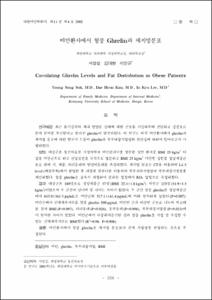KUMEL Repository
1. Journal Papers (연구논문)
1. School of Medicine (의과대학)
Dept. of Family Medicine (가정의학)
비만환자에서 혈중 Ghrelin과 체지방분포
- Keimyung Author(s)
- Suh, Young Sung; Kim, Dae Hyun; Lee, In Kyu
- Journal Title
- 대한비만학회지
- Issued Date
- 2002
- Volume
- 11
- Issue
- 4
- Abstract
- Background: Obesity has become a matter of great public concern in Korea with its increasing prevalence in recent years. People should properly recognize themselves whether to be obese or not before seeking medical attention. However selfassessment of obesity may be erroneously subjective and misleading. This study is to investigate the possible discrepancy between self-assessment of obesity and obesity defined by BMI in Korean adults.
Materials And Methods: Five hundred sixty one adult subjects (341 men and 220 women) who took a routine health examination in Gachon Health Center were included in this study. We analyzed the data obtained from health examination and a questionnaire including self-assessment of obesity categorized as underweight, normal, obese and severely obese. Body mass index (BMI) ≥25 kg/m2 is defined as obese, BMI ≥30 kg/m2 as very obese and BMI <20 kg/m2 as underweight.
Results: The age of the subjects was 37±13 years, male to female ratio 1.5:1, the BMI 22.7± 3.2 kg/m2, and the WHR 0.85±.0.07. The concordance rates between self-assessment of obesity and obesity defined by BMI were 56%, 52%, 49% and 89% (kappa=0.26) respectively in underweight, normal, obese and very obese. 44% of men with obesity (BMI ≥25 kg/m2) assessed themselves to be non-obese, whereas 43% of non-obese women (BMI <25 kg/m2) assessed themselves to be obese. There were no differences in age, education level, and residential area between the groups who correctly assessed their obesity and did not.
Conclusions: There were significant discrepancies between self-assessment of obesity and obesity defined by BMI in Korean adults. Significant proportion of men with obesity underestimated their obesity, while significant proportion of non-obese women overestimated their fatness. These results suggest that public education be required to provide the proper definition of obesity and avoid the misleading in its management.
연구배경: 최근 음식섭취와 체내 영양분 상태에 대한 신호를 시상하부에 전달하고 성장호르몬의 분비를 촉진한다고 알려진 ghrelin이 발견되었다. 이 연구는 아직 비만환자에서 ghrelin과 체지방 분포에 대한 연구가 드물어 ghrelin과 복부내장지방량의 관련성에 대하여 알아보고자 시행하였다. 방법: 대상군은 동산의료원 가정의학과 비만클리닉을 방문한 성인 환자중 BMI 25 kg/m2 이상을 비만군으로 하고 건강검진을 목적으로 방문하고 BMI 25 kg/m2 미만인 성인을 정상체중군으로 하여 키, 체중, 허리둘레와 엉덩이둘레를 측정하였다. 체지방 분포는 CT를 이용하여 L4-5 level (배꼽부위)에서 촬영한 후 내장된 컴퓨터를 이용하여 복부피하지방량과 복부내장지방량을 계산하였다. 혈중 ghrelin은 공복시 채혈하여 분리된 혈청에서 RIA 방법으로 측정하였다.
결과: 대상군은 180명으로 정상체중군 57명 (BMI 22.4 1.8 kg/m2) 비만군 123명 (31.9 3.3 kg/m2)이었으며 두 군간의 남녀비 및 나이는 차이가 없었다. 두 군간 혈중 ghrelin은 정상체중군에서 615.0 341.3 pg/mL로 비만군의 517.1 141.4 pg/mL에 비해 현저하게 높았다 (P=0.007). 비만군에서 신체계측지수를 혈중 ghrelin 500 pg/mL 미만인 군과 이상인 군으로 나누어 비교해 본 결과 BMI (P=0.007), 허리둘레 (P=0.026), 둔부둘레 (P=0.006), 복부내장지방량 (P=0.023)에서 현저한 차이가 있었다. 비만군에서 다중회귀분석한 결과 혈중 ghrelin을 가장 잘 추정할 수 있는 신체계측지수는 BMI였다 (R2=0.06, P=0.006).
결론: 비만환자에서 혈중 ghrelin은 체지방 분포보다 전체 지방량을 반영하는 것으로 추정된다.
- Alternative Title
- Circulating Ghrelin Levels and Fat Distribution in Obese Patients
- Publisher
- School of Medicine
- Citation
- 서영성 et al. (2002). 비만환자에서 혈중 Ghrelin과 체지방분포. 대한비만학회지, 11(4), 356–361.
- Type
- Article
- ISSN
- 1226-4407
- Appears in Collections:
- 1. School of Medicine (의과대학) > Dept. of Family Medicine (가정의학)
1. School of Medicine (의과대학) > Dept. of Internal Medicine (내과학)
- 파일 목록
-
-
Download
 oak-bbb-1455.pdf
기타 데이터 / 340.5 kB / Adobe PDF
oak-bbb-1455.pdf
기타 데이터 / 340.5 kB / Adobe PDF
-
Items in Repository are protected by copyright, with all rights reserved, unless otherwise indicated.